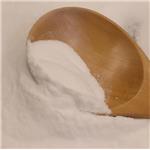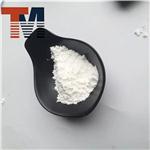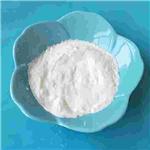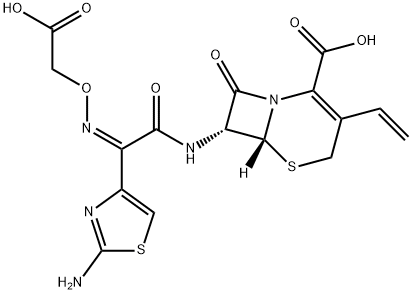Cefixime
- CAS No.
- 79350-37-1
- Chemical Name:
- Cefixime
- Synonyms
- CEFIXIME TRIHYDRATE;Cefixim;Cefspan;Suprax;Cefixime USP;CEFIXIME MICRONIZED;CFIX;fk027;Oroken;Saprax
- CBNumber:
- CB4210362
- Molecular Formula:
- C16H15N5O7S2
- Molecular Weight:
- 453.45
- MDL Number:
- MFCD03788802
- MOL File:
- 79350-37-1.mol
- MSDS File:
- SDS
| Melting point | 218-225°C |
|---|---|
| Density | 1.85±0.1 g/cm3(Predicted) |
| storage temp. | Keep in dark place,Inert atmosphere,2-8°C |
| solubility | Slightly soluble in water, soluble in methanol, sparingly soluble in anhydrous ethanol, practically insoluble in ethyl acetate. |
| pka | pKa 2.10 (Uncertain) |
| form | Solid |
| color | Off-White to Pale Yellow |
| Water Solubility | 55.11 mg/L |
| BCS Class | 4 |
| Stability | Hygroscopic |
| CAS DataBase Reference | 79350-37-1(CAS DataBase Reference) |
| NCI Dictionary of Cancer Terms | cefixime |
| FDA UNII | XZ7BG04GJX |
| NCI Drug Dictionary | cefixime |
| ATC code | J01DD08 |
SAFETY
Risk and Safety Statements
| Symbol(GHS) |  GHS07 |
|---|---|
| Signal word | Warning |
| Hazard statements | H302-H315-H319-H335 |
| Precautionary statements | P261-P305+P351+P338 |
| Hazard Codes | Xn |
| Risk Statements | 42/43 |
| Safety Statements | 22-36/37-45 |
| WGK Germany | 3 |
| F | 10-23 |
| HS Code | 38210000 |
| Toxicity | LD50 oral in rat: > 10gm/kg |
Cefixime price More Price(21)
| Manufacturer | Product number | Product description | CAS number | Packaging | Price | Updated | Buy |
|---|---|---|---|---|---|---|---|
| Sigma-Aldrich | CDS021590 | Cefixime | 79350-37-1 | 100MG | $119 | 2023-06-20 | Buy |
| Cayman Chemical | 17176 | Cefixime ≥95% | 79350-37-1 | 100mg | $113 | 2024-03-01 | Buy |
| Cayman Chemical | 17176 | Cefixime ≥95% | 79350-37-1 | 1mg | $25 | 2021-12-16 | Buy |
| Cayman Chemical | 17176 | Cefixime ≥95% | 79350-37-1 | 5mg | $81 | 2021-12-16 | Buy |
| Cayman Chemical | 17176 | Cefixime ≥95% | 79350-37-1 | 10mg | $29 | 2024-03-01 | Buy |
Cefixime Chemical Properties,Uses,Production
Brand Name(s) in US
Suprax
Cephalosporin antibiotics
Cefixime is a third-generation oral cephalosporin antibiotic, also known as Oroken, Suprax, Cefspan, in clinic used for the treatment of bacterial infectious diseases caused by Streptococcus (except Enterococci), Pneumonia chain, Neisseria gonorrhoeae, Escherichia coli, Branhamella catarrhalis, Serratia bacteria, Citrobacter, Enterobacter cloacae, Enterobacter aerogenes, Haemophilus influenzae, Klebsiella, Serratia, Proteus and Haemophilus Influenzae, etc. the indications are as follow:
1. respiratory infections, such as pneumonia, tonsillitis, pharyngitis, bronchiectasis (infection), secondary infection of chronic respiratory infectious diseases ,acute and chronic bronchitis, etc.
2. urinary and reproductive tract infections, such as gonococcal urethritis, cervicitis, pyelonephritis, cystitis, gonorrhea , etc.
3. intra-abdominal infections (including cholecystitis, cholangitis, peritonitis).
4. scarlet fever, otitis media, sinusitis and so on.
Mechanism of action
Antibacterial mechanism of action in Cefixime is similar to other third-generation cephalosporins, through combined with one or more penicillin-binding proteins (PBPs), inhibits cell wall synthesis of bacterial dividing cells. PBPs is located in the cytoplasmic membrane of bacteria, possibly is catalyzing enzyme of bacterial cell wall synthesis last phase. The role of the results of this product is to make the bacteria form defective cell wall which is unstable for osmotic pressure, thereby having an antibacterial effect. Different strains have their own unique PBPs. Different affinity of Cefixime on different PBPs is the main factor affecting its activity of antibacterial spectrum.
Drug Interactions
1. in combination with aminoglycoside antibiotics have synergistic antibacterial effect on certain sensitive strains.
2. there are reports that aspirin may increase the blood concentration of Cefixime.
3. in combination with aminoglycosides or other cephalosporins will increase the renal toxicity.
4. in combination with strong diuretics such as furosemide can enhance nephrotoxicity.
5. in combination with chloramphenicol may have mutual antagonism.
6. probenecid can prolong the excretion of Cefixime and elevated blood concentrations.
The above information is edited by the chemicalbook of Liu Yujie.
Precautions
1. Cross allergy: patients who are allergic to a cephalosporin or head neomycin (cephamycin) may be allergic to other cephalosporins or head neomycin. Who are allergic to penicillins, penicillin derivatives, or penicillamine may also be allergic to cephalosporins or head neomycin.
2. Contraindication: patients who are allergic to this product and other cephalosporins are disabled.
3. Used with caution:
(1) patients who are allergic to penicillin antibiotic are used with caution.
(2) pregnant women, lactating women, newborns and preterm children are used with caution.
(3) severe liver and kidney dysfunction are used with caution.
(4) highly allergic constitution are used with caution.
(5) the elderly, frail patients are used with caution.
4. Effects on the diagnosis:
(1) It may be false positive when copper sulfate method to determine urine sugar.
(2) direct antiglobulin test (Coomb's test) were positive reaction.
(3) a small number of patients after treatment may appear increased alkaline phosphatase, serum alanine aminotransferase and serum aspartate aminotransferase, serum creatinine and blood urea nitrogen.
5. Monitoring items when must use:
(1) long-term medication should regularly check liver and kidney function, and blood and urine routines.
(2) patients with liver and renal damage should monitor blood concentration when use Cefixime.
Chemical properties
White or light yellow crystalline powder, odorless or slight smell. Soluble in ethanol or dimethyl sulfoxide, slightly soluble in acetone, almost insoluble in ethanol, hexane, ethyl acetate or water. Acute toxicity mindanao. Mouse, rat (mg/kg): All> 10,000 orally; 5000,7000 intravenous injection.
(Z)-Cefixime Disodium:C16H13N5O7S2Na2. Melting point>250℃.
(E)-Cefixime trihydrate: C16H15N5O7S2 3H2O?. A pale yellow solid, melting point is 218~225 ℃ (decomposition).
Uses
The third-generation oral cephalosporin class of broad-spectrum antibiotics, has strong antibacterial effect on Gram-positive bacteria such as Streptococcus, and Gram-negative bacteria such as Neisseria gonorrhoeae, Haemophilus influenzae, , as well as E. coli , Klebsiella pneumoniae, Proteus mirabilis, which are resistance to cefaclor, cephalexin, cefadroxil resistant, and is stable for β-lactamase produced by various bacteria. Long-acting, efficient and can be administered once a day. Clinically used for respiratory tract infections,urinary tract infections and biliary tract infections caused by susceptible strains.
Production methods
Method 1: 7-ACA as a raw material.
7-ACA (18.7 g, 67 mmol) was suspended in mixed solution of 120 ml water and 120 ml methanol, dropwise added sodium hydroxide (5.5 g, 142 mmol) dissolved in 18 ml aqueous solution at-20 ℃, stirred at-10 ~-20℃ for 25 min, used concentrated hydrochloric acid to neutralize Ph: 7.5. Added salicylaldehyde (10.7 g, 87.6 mmol) at 15 ℃, then stirred for 1h. Added diphenyl diazomethane (15.7g, 80.9mmo1) in 85 ml of ethyl acetate solution, continued to stir for 1h. During the reaction, used 1 mol/L hydrochloric acid to maintain that Ph value of the reaction solution was 4.0 to 4.5. The reaction solution was extracted with 550 ml of ethyl acetate and the extract was washed with brine, concentrated under reduced pressure. The residue was impregnated with petroleum ether to give 29.6 g compound (the I), yield was 78.1%, melting point was 97~98.5 ℃ (decomposition). Compound (I) (1.01 g, 2 mmol) was dissolved in 10 ml of dichloromethane was added phosphorous pentachloride (0.46 g, 2.2 mmol) and pyridine (0.176 g, 2.2 mmol) at-30℃, stirred for 1h at-20 to-30℃. The reaction solution was poured into ice water, the organic layer was separated, washed with brine, dried, concentrated under reduced pressure. Obtained 0.9 g compound (Ⅱ), yield was 85.7%, melting point was 180.5~182.0 ℃.
Compound (Ⅱ) (4.0 g, 7.6 mmol) was dissolved in 10 ml of dimethylformamide, under cooled and stirred, added triphenylphosphine (2.2 g, 8.4 mmol). After addition, the mixture was stirred at room temperature for 2 h. The reaction solution was poured into 250 ml of isopropanol, the precipitate was collected by filtration (6.7 g). The precipitate was dissolved in 10 ml of dichloromethane and 5 ml of water, added 17.4 ml 36% aqueous solution of formaldehyde. Used 10 % sodium carbonate aqueous solution to adjust Ph = 9.0. After stirred at room temperature for 1 h, extracted with 20ml dichloromethane. The extract was washed with brine, dried, concentrated under reduced pressure. Obtained 3.0 g compound (Ⅲ), yield was 78.9%, melting point was 180.5~182 ℃ (decomposition).
Compound (Ⅲ) (18.96 g, 38.2 mmol) was dissolved in mixture of 135 ml ethyl acetate and 34 ml ethanol, added 5.7 ml of concentrated hydrochloric acid at room temperature and stirred for 1.5 h. The precipitate was collected by filtration, washed with ethyl acetate and dried. Obtained 11.32 g compound (Ⅳ), yield was 69%, melting point was 172~173 ℃ (decomposition).
Under-5~0 ℃ and stirred, phosphorus oxychloride (7.7 g, 50.1 mmol) was dropwise added into dimethyl formamide (3.66 g, 50.1 mmol) and 80 ml of tetrahydrofuran , stirred for 30 min to give Vismeier reagent. Under ice-cooling, the compound (V) (13.8 g, 41.8 mmol), and then stirred for 1 h to give a solution of the active compound (V) . At-20 ℃, and the solution was added to the compound (Ⅳ) (15 g, 34.9 mmol) and N-(trimethylsilyl) acetamide (MSA) (32 g, 244 mol) in 150 ml of ethyl acetate solution, continued to stir for 30 min. Added ethyl acetate and water, the organic layer was separated, washed with 5% sodium bicarbonate solution and brine, and dried. Concentrated under reduced pressure, the residue was impregnated with isopropyl alcohol to give 23.1 g compound (Ⅵ), yield was 97.5%.
Compound (Ⅵ) (19.0 g, 28.0 mmol) was dissolved in 380 ml of methanol, added concentrated hydrochloric acid (11.6 g, 112 mmol) at room temperature, and stirred for 1h. With 5% aqueous sodium bicarbonate and concentrated under reduced pressure. After the residue was dissolved in ethyl acetate, washed with brine, and dried. Concentrated under reduced pressure, the residue was impregnated with isopropyl alcohol to give 15.3 g compound (VII), yield was 84.1%.
Compound (Ⅶ) (15.0 g, 23 mmol) was dissolved in 15 ml of anisole, cooled in an ice bath, 60 ml trifluoroacetic acid was added. After addition, stirred for 80 min at room temperature. Under stirred, the reaction was dropwise added into 600 ml of isopropanol. The resulting precipitate was collected by filtration, dissolved in 5% aqueous sodium bicarbonate, washed with ethyl acetate. Used 5% hydrochloric acid the aqueous solution to adjust Ph = 6.0, used a macroporous non-ionic absorption resin (Diaion HP-20) column chromatography, eluted with water. Under cooling, used 10% hydrochloric acid effluent to acidify Ph = 2.3. The precipitate was collected by filtration and dried to give 3.55 g Cefixime, yield was 34.1%.
Method 2: deacetyl cephalosporin C as raw materials.
Deacetyl cephalosporin C sodium salt (118.6 g, 0.3 mol) was dissolved in 1.0 L water and 0.6 L acetone, added benzoyl chloride (42.1 g, 0.3 mol) at 10~15 ℃, during the addition, used 20 % sodium carbonate solution to maintain the reaction solution at Ph value of 6.5 to 7.5. After addition, under 10~15 ℃ stirred for 1 h. Acetone was distilled off under reduced pressure, the remaining aqueous solution was washed with ethyl acetate. 300 ml of ethyl acetate was added to the aqueous solution, added diazo diphenyl methane (135.8 g, 0.75 mol) solution in 1.0 L of ethyl acetate. After used concentrated hydrochloric acid to adjust Ph = 3.5, followed by stirred at room temperature for 1.5 h. Used concentrated hydrochloric acid to adjust the reaction solution to Ph = 2.5, the organic layer was separated, washed with brine, dried, concentrated under reduced pressure. The residue was dissolved in 400 ml of acetone, added 4.0 L isopropyl ether. The precipitate was collected to give 224.8 g compound (VIII), yield was 92.5%.
Compound (Ⅷ) (100 g, 0.123 mol) was dissolved in 600 ml of dichloromethane, added phosphorous pentachloride (25.6 g, 0.123 mol) at-30 ℃, added pyridine (9.8 g, 0.123 mol). After stirred at-20~10 ℃ for 1 h, the reaction solution was poured into mixture of 500 ml dichloromethane and 300 ml water. The dichloromethane layer was separated, washed with brine, dried, and concentrated under reducedl. The residue was impregnated with isopropyl ether to give 114.5 g of powdery compound (IX), yield was 98%.
Compound (Ⅸ) (102 g, 0.123 mol) was dissolved in 300 ml of dimethylformamide, added sodium iodide (18.4 g, 0.123 mol) at 35 ℃, stirred for 30 min. Added triphenylphosphine (48.5 g, 0.185 moL), stirred at 35~38 ℃ for 1 h. Concentrated under reduced pressure to a residual volume of 2/3, which was dropwise added into 5.0 L of isopropyl alcohol. The precipitate was collected by filtration, washed with isopropyl ether, and dried. Concentrated under reduced pressure, about 123.5 g of the remaining solid was dissolved in 1.0 L of dichloromethane, added 300 ml 36% formaldehyde at 25 ℃, stirred for 2h, and treated with 20% sodium carbonate to maintain at Ph value of 9.0. After completion of the reaction, used 10% hydrochloric acid to adjust at Ph = 5.0. The organic layer was separated, washed with brine, and evaporated under reduced pressure. The residue was impregnated with ethyl acetate to give 63.5 g powdery compound (X), yield was 75.8%. At 5 ℃, pyridine (5.9 g, 74.4 mmol) was added into phosphorus pentachloride (15.5 g, 74.4 mmol) in 200 ml of dichloromethane, stirred for 20 min. Compound (X) was added at 5 ℃, stirred for 2 h, cooled to-40 ℃, also was added at once 120 ml of methanol cooled to-40 ℃. The reaction solution was gradually raised to 20 ℃ within 1 h. The reaction solution was concentrated under reduced pressure, the residue was impregnated with 300 ml of ethyl acetate and 50 ml water. The precipitate was collected by filtration, washed twice with 50 ml of isopropanol, and then washed with 50 ml isopropyl ether. 8.4g crystalline compound (Ⅳ) was obtained, a yield of 79.0%.
Compound (Ⅳ) was reacted as the same method 1 to obtain Cefixime.
Description
Cefixime is the first orally active third-generation cephalosponn with a true broad spectrum of activity. It is reportedly more effective against Gram-negative bacteria than conventional oral cephems such as cephalexin and cefaclor.
Chemical Properties
Pale Yellow Solid
Chemical Properties
Cefixime is an oral third generation cephalosporin antibiotic. It was sold under the trade name Suprax in the United States until 2003. The oral suspension form of “Suprax” was re-launched. Cefixime is prescribed for bacterial infections of the chest, ears, urinary tract, and throat (tonsilitis and pharyngitis), and for uncomplicated gonorrhea, upper and lower respiratory tract infections, acute otitis media, and gonococcal urethritis.
Originator
Fujisawa (Japan)
Uses
Orally active, third generation cephalosporin antibiotic.
Uses
Cephalosporin antibacterial
Definition
ChEBI: A third-generation cephalosporin antibiotic bearing vinyl and (2Z)-2-(2-amino-1,3-thiazol-4-yl)-2-[(carboxymethoxy)imino]acetamido groups at positions 3 and 7, respectively, of the cephem skeleton. It is used in the treatment of gonorrhoea tonsilitis, pharyngitis, bronchitis, and urinary tract infections.
Manufacturing Process
To a suspension of 7-amino-3-vinyl-3-cephem-4-carboxylic acid (11.25 g), 2- (aminothiazol-4-yl)-2-(tert-butoxycarbonylmethoxyimino)acetic acid S-mercaptobenzothiazole ester (23.88 g) in ethylacetate (266 ml) and water (9 ml) at 2°C is added triethylamine. After completion of the reaction, water is added and pH is adjusted to 2.1 with diluted sulfuric acid. The phases are separated and the aqueous phase is extracted with ethylacetate. The organic extracts are combined and concentrated to a volume of 120 ml, then acetonitrile (100 ml) and formic acid (22 ml) are added. The mixture is stirred at 30-35°C for 1 hour. The mixture is cooled to 2°C, the precipitate is filtered, washed with acetonitrile and dried to obtain 20.86 g of 5-thia-1- azabicyclo(4.2.0)oct-2-ene-2-carboxylic acid, 7-(((2Z)-(2-amino-4- thiazolyl)(carboxymethoxy)imino)acetylamino)-3-ethenyl-8-oxo-, (6R,7R)- (Cefixime).
brand name
Suprax(Lupin);Cefspan.
Therapeutic Function
Antibiotic
Antimicrobial activity
It is active against N. gonorrhoeae, M. catarrhalis, H. influenzae and a wide range of enterobacteria, including most strains of Citrobacter, Enterobacter and Serratia spp. Its antistaphylococcal activity is poor. It is not active against Acinetobacter spp., Ps. aeruginosa or B. fragilis. It is resistant to hydrolysis by common β-lactamases.
Health Hazard
Exposures to cefi xime may cause side effects that include, but are not limited to, stomach and abdominal pain, diarrhea, vomiting, mild skin rash, headache, fever, urticaria, pruritis, eosinophilia, leucopenia, anaphylaxis, superinfection, hemolytic anemia, dyspepsia, and fl atulence. Also, cefi xime may cause transient elevation of SGOT, SGPT, alkaline phosphatase, BUN, and creatinine. Reports have indicated that cefi xime is mainly excreted unchanged in the bile and urine
Pharmacokinetics
Oral absorption: c. 50%
Cmax 400 mg oral: 4–5.5 mg/L after 4 h
Plasma half-life: 3-ndash;4 h
Volume of distribution: 0.1 L/kg
Plasma protein binding: 60-ndash;70%
Absorption and distribution
Oral absorption is slow and incomplete, but is unaffected by aluminum magnesium hydroxide. Penetration into cantharides blister fluid was very slow but exceeded the plasma level. CSF concentrations are poor even in the presence of meningeal inflammation, reaching an average of around 0.22 mg/L in children with meningitis.
Metabolism and excretion
It is not metabolized and is excreted unchanged in urine (mainly by glomerular filtration) and in bile, in which concentrations exceeding 100 mg/L have been found. Less than 20% of an oral dose is recovered from the urine over 24 h, falling to less than 5% in patients with severe renal impairment, with a corresponding increase in plasma concentration. It is not removed by peritoneal or hemodialysis.
Clinical Use
Cefixime (Suprax) is the first orally active, third-generationcephalosporin that is not an ester prodrug to be approved fortherapy in the United States. Oral bioavailability is surprisinglyhigh, ranging from 40% to 50%. Facilitated transportof cefixime across intestinal brush border membranes involvingthe carrier system for dipeptides may explain itssurprisingly good oral absorption. This result was not expectedbecause cefixime lacks the ionizable α-amino grouppresent in dipeptides and β-lactams previously known to betransported by the carrier system.Cefixime is a broad-spectrum cephalosporin that is resistantto many β-lactamases. It is particularly effective againstGram-negative bacilli, including E. coli, Klebsiella spp., P.mirabilis, indole-positive Proteus, Providencia, and someCitrobacter spp. Most Pseudomonas, Enterobacter, andBacteroides spp. are resistant. It also has useful activityagainst streptococci, gonococci, H. influenzae, and M. catarrhalis.It is much less active against S. aureus. Cefixime isused for the treatment of various respiratory tract infections(e.g., acute bronchitis, pharyngitis, and tonsillitis) and otitismedia. It is also used to treat uncomplicated urinary tract infectionsand gonorrhea caused by β-lactamase–producingbacterial strains.
The comparatively long half-life of cefixime (t1/2 is3–4 hours) allows it to be administered on a twice-a-dayschedule. Renal tubular reabsorption and a relatively high fraction of plasma protein binding (~65%) contribute to thelong half-life. It is provided in two-oral dosage forms: 200-or 400-mg tablets and a powder for the preparation of anaqueous suspension.
Clinical Use
Cefixime has been used successfully in uncomplicated cystitis, upper and lower respiratory tract infections and various other infections. Its failure to provide adequate cover for staphylococci should be noted.
Side effects
It is well tolerated, but diarrhea is fairly common and pseudomembranous colitis has been reported. Other side effects common to cephalosporins are occasionally seen.
Veterinary Drugs and Treatments
Uses for cefixime are limited in veterinary medicine. Its use should be reserved for those times when infections (systemic or urinary tract) are caused by susceptible gram-negative organisms where oral treatment is indicated or when approved fluoroquinolones or other 3rd generation cephalosporins (e.g., cefpodoxime) are either contraindicated or ineffective.
in vitro
previous study found that cefixime was more active than cephalexin, cefaclor, and amoxicillin against various gram-negative bacteria. cefixime was also significantly more active than tested reference drugs against clinical isolates of klebsiella pneumoniae, escherichia coli, indole-positive and -negative proteus species, providencia species, and neisseria gonorrhoeae. moreover, cefixime was active against strains of k. pneumoniae, e. coli, as well as proteus mirabilis resistant to the reference agents [1].
in vivo
the therapeutic activities of cefixime in mice infected with gram-negative bacilli were found to be far superior to the activities of cephalexin, cefaclor, and amoxicillin, but they were inferior to the activities against infection with staphylococcus aureus [1].
Drug interactions
Potentially hazardous interactions with other drugs
Anticoagulants: effects of coumarins may be
enhanced.
Metabolism
About 20% of an oral dose (or 50% of an absorbed dose) is excreted unchanged in the urine via glomerular filtration within 24 hours. Up to 60% may be eliminated by non-renal mechanisms; there is no evidence of metabolism but some drug is probably excreted into the faeces from bile.
Precautions
Users of cefi xime should be careful in health conditions such as neonates, pregnancy, lactation, and renal failure. Users should follow suitable and appropriate health care measures to control superinfection (if it happens during therapy). It is contraindicated in patients with a known allergy to penicillin or any other ingredients of Taximax. Taxim-O is contraindicated in patients with a known allergy to the cephalosporin group of antibiotics.
References
[1] kamimura, t. ,kojo, h.,matsumoto, y., et al. in vitro and in vivo antibacterial properties of fk 027, a new orally active cephem antibiotic. antimicrobial agents and chemotherapy 25(1), 98-104 (1984).
[2] quintiliani r. cefixime in the treatment of patients with lower respiratory tract infections: results of us
Cefixime Preparation Products And Raw materials
Raw materials
1of3
Preparation Products
| Supplier | Tel | Country | ProdList | Advantage | |
|---|---|---|---|---|---|
| Henan Tengmao Chemical Technology Co. LTD | +8615238638457 | salesvip2@hntmhg.com | China | 415 | 58 |
| Henan Bao Enluo International TradeCo.,LTD | +86-17331933971 +86-17331933971 | deasea125996@gmail.com | China | 2503 | 58 |
| Guangzhou Tengyue Chemical Co., Ltd. | +86-86-18148706580 +8618826483838 | evan@tyvovo.com | China | 152 | 58 |
| Shaanxi TNJONE Pharmaceutical Co., Ltd | +86-13474506593 +86-13474506593 | sarah@tnjone.com | China | 794 | 58 |
| Capot Chemical Co.,Ltd. | 571-85586718 +8613336195806 | sales@capotchem.com | China | 29797 | 60 |
| Henan Tianfu Chemical Co.,Ltd. | +86-0371-55170693 +86-19937530512 | info@tianfuchem.com | China | 21695 | 55 |
| career henan chemical co | +86-0371-86658258 | sales@coreychem.com | China | 29914 | 58 |
| Wuhan Boyuan Import & Export Co., LTD | +8615175982296 | Mike@whby-chem.com | China | 974 | 58 |
| Shaanxi Yikanglong Biotechnology Co., Ltd. | 17791478691 | yklbiotech@163.com | CHINA | 296 | 58 |
| Hebei Guanlang Biotechnology Co., Ltd. | +86-19930503282 | alice@crovellbio.com | China | 8822 | 58 |
Related articles
- Cefixime: Antimicrobial Activity, Susceptibility, Administration and Dosage, Clinical Uses etc.
- Cefixime is an orally administered cephalosporin with a broader antimicrobial spectrum than those of earlier oral cephalospori....
- Mar 24,2022
View Lastest Price from Cefixime manufacturers
| Image | Update time | Product | Price | Min. Order | Purity | Supply Ability | Manufacturer | |
|---|---|---|---|---|---|---|---|---|
 |
2024-04-09 | Cefixime
79350-37-1
|
US $0.00 / Kg | 1Kg | 99% | 10kg | Shaanxi TNJONE Pharmaceutical Co., Ltd | |
 |
2024-01-27 | Cefixime
79350-37-1
|
US $110.00-90.00 / kilogram | 1kilogram | 99% | 10 tons/per week | Henan Tengmao Chemical Technology Co. LTD | |
 |
2024-01-08 | Cefixime
79350-37-1
|
US $60.00-45.00 / kg | 1kg | 99.5% | 500tons | Wuhan Boyuan Import & Export Co., LTD |





